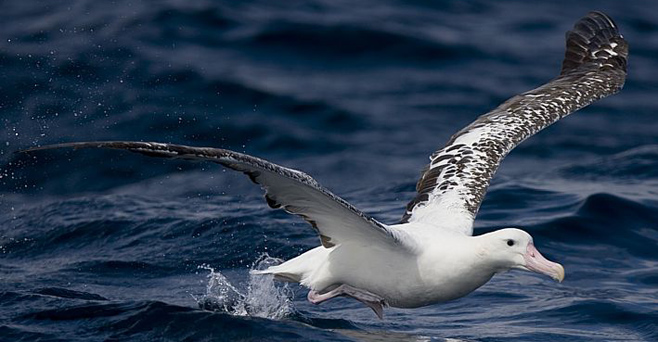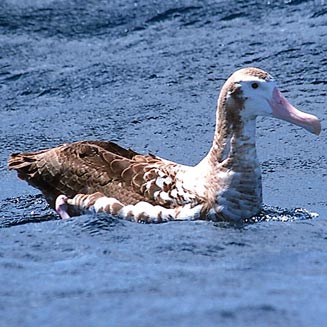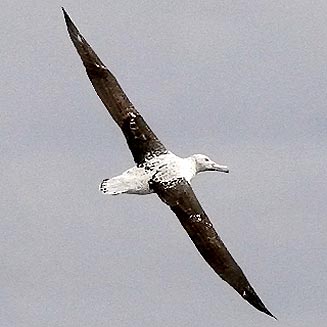|
Diomedea exulans (Wandering
albatross)
Grootalbatros [Afrikaans]; Grootmalmok [Afrikaans]; Grote
albatros, Reuzenalbatros [Dutch]; Albatros hurleur [French];
Wanderalbatroß [German]; Albatroz-viageiro [Portuguese]
Life
> Eukaryotes >
Opisthokonta
> Metazoa (animals) >
Bilateria >
Deuterostomia > Chordata >
Craniata > Vertebrata (vertebrates) > Gnathostomata (jawed
vertebrates) > Teleostomi (teleost fish) > Osteichthyes (bony fish) > Class:
Sarcopterygii (lobe-finned
fish) > Stegocephalia (terrestrial
vertebrates) > Tetrapoda
(four-legged vertebrates) > Reptiliomorpha > Amniota >
Reptilia (reptiles) >
Romeriida > Diapsida > Archosauromorpha > Archosauria >
Dinosauria
(dinosaurs) > Saurischia > Theropoda (bipedal predatory dinosaurs) >
Coelurosauria > Maniraptora > Aves
(birds) > Order: Ciconiiformes
> Family: Diomedeidae
 |
| Wandering albatross, offshore from
Cape Town, South Africa. [photo Trevor Hardaker ©] |
 |
 |
| Wandering albatross (3rd or 4th
cycle). [photo Jeff Poklen ©] |
Wandering albatross, 4th or 5th cycle. [photo
Jeff Poklen
©] |
Distribution and habitat
Breeds on sub-Antarctic islands, including South Georgia,
Prince Edward, Crozet, Kerguelen, Macquarie and occasionally Heard Island. In
the non-breeding season it disperses across the southern oceans, occuring across
much of southern African waters excluding the area east of Mozambique, while
most common below 30° South. It is a rare vagrant further north, as it has
occasionally been recorded further north to the North Atlantic and North Pacific
Oceans.
Movements and migrations
Present year-round off southern Africa,
although it is by far the most common in Winter. After breeding it
heads north, typically covering 6000-8000 km in just 6-10 days at an
average speed of 35-38 km/hr.
Food
It mainly scavenges dead food on the surface of the sea,
using its massive wingspan of up to 3.7m to soar across the oceans, flying in
loops to cover large areas or alternatively landing in the water regularly and
searching more intently (usually in areas where food is more abundant). It is
primarily a diurnal feeder, occasionally hunting at night by using a
sit-and-wait technique, sitting on water and grabbing prey on the water surface.
The following food items have been recorded in its diet at its breeding colonies
- the percentages indicate the approximate proportion of that food item in its
diet.
- squid (40-77%)
- fish (15-42%)
- other (<1%)
- crustaceans
- carrion
- tunicates
- jellyfish
Threats
Vulnerable, with a population of of approximately
9000 breeding pairs, largely due to mortalities on longlines of fishing vessels.
Thankfully, changes in fishing practices have improved the situation
considerably, although its slow reproductive rate leaves it at risk to further
disruptions.
References
-
Hockey PAR, Dean WRJ and Ryan PG 2005. Roberts
- Birds of southern Africa, VIIth ed. The Trustees of the John Voelcker
Bird Book Fund, Cape Town.
|
